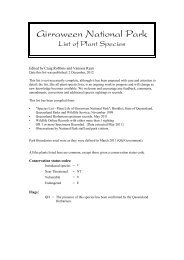Vegetation of Girraween National Park - Flora ... - www.rymich.com!
Vegetation of Girraween National Park - Flora ... - www.rymich.com!
Vegetation of Girraween National Park - Flora ... - www.rymich.com!
You also want an ePaper? Increase the reach of your titles
YUMPU automatically turns print PDFs into web optimized ePapers that Google loves.
Geology<br />
Explorer and botanist Allan Cunningham first visited the area in June 1827. His diary entry for the<br />
26th <strong>of</strong> June 1827 states:<br />
“Large detached masses <strong>of</strong> granite <strong>of</strong> every shape towering above each other, and in<br />
many instances standing in almost tottering positions, constituted a barrier before<br />
us; beyond these a deep ravine formed a curve from E. to S.W., which was itself<br />
bounded by a rocky ridge at least 250 feet high.”<br />
<strong>Girraween</strong> <strong>National</strong> <strong>Park</strong> and its associated flora and vegetation <strong>com</strong>munities are influenced by the<br />
underlying geology, in this case granite, and its associated soils. The Stanthorpe Granite was intruded as a<br />
molten mass deep below the surface about 240 million years ago in the early Triassic period, where it<br />
cooled and crystallised slowly to a coarse-grained rock. Since then erosion has removed the overlying rocks<br />
and exposed the granite mass. Where this has been closely fractured, erosion has created valleys, but<br />
where less fractured, great domes and slabs <strong>of</strong> bare rock have remained. Granite breaks down<br />
(de<strong>com</strong>poses), by environmental and chemical processes, into coarse sandy soils that provide limited<br />
fertility and water holding capacity (Wilmott 2004, pp. 49, 51). Fine clays resulting from the de<strong>com</strong>position<br />
<strong>of</strong> the feldspar in the granite tend to wash away easily, leaving only the more coarse quartz grains. The<br />
depth <strong>of</strong> soils is shallow except in riparian areas where the <strong>com</strong>ponents <strong>of</strong> de<strong>com</strong>posed granite can<br />
accumulate. Plant nutrients such as calcium, magnesium and iron are limited due to the lack <strong>of</strong> these<br />
minerals in the parent rocks (Wilmott 2004). This underlying geology and associated soils influence the<br />
plant species and vegetation <strong>com</strong>munities that populate the area.<br />
Climate<br />
During summer, days are a warm 28-32°C, with nights averaging 15-18°C. Winters are usually dry<br />
and cold with overnight temperature falling to an average minimum <strong>of</strong> -4°C and sunny days reaching 15-<br />
22°C. Most years in winter there are heavy frosts, sleet and even light snowfalls. Heavy snow falls have<br />
been recorded. Officially recorded temperature extremes vary from -16°C to 40°C. Most rain falls between<br />
November and March with an average annual rainfall <strong>of</strong> 850 mm per year; the eastern areas <strong>of</strong> the park<br />
receive the highest rainfall totals (McDonald, et. al 1995). This gradient <strong>of</strong> rainfall, between the western and<br />
eastern areas <strong>of</strong> the park, and in addition to the geological and topography <strong>of</strong> the park mentioned briefly<br />
above, influences the vegetation <strong>com</strong>munities and individual species that occupy various sections <strong>of</strong> the<br />
park (McDonald, et. al 1995).<br />
<strong>Vegetation</strong> <strong>of</strong> <strong>Girraween</strong> <strong>National</strong> <strong>Park</strong>, July 2011<br />
Page 9




